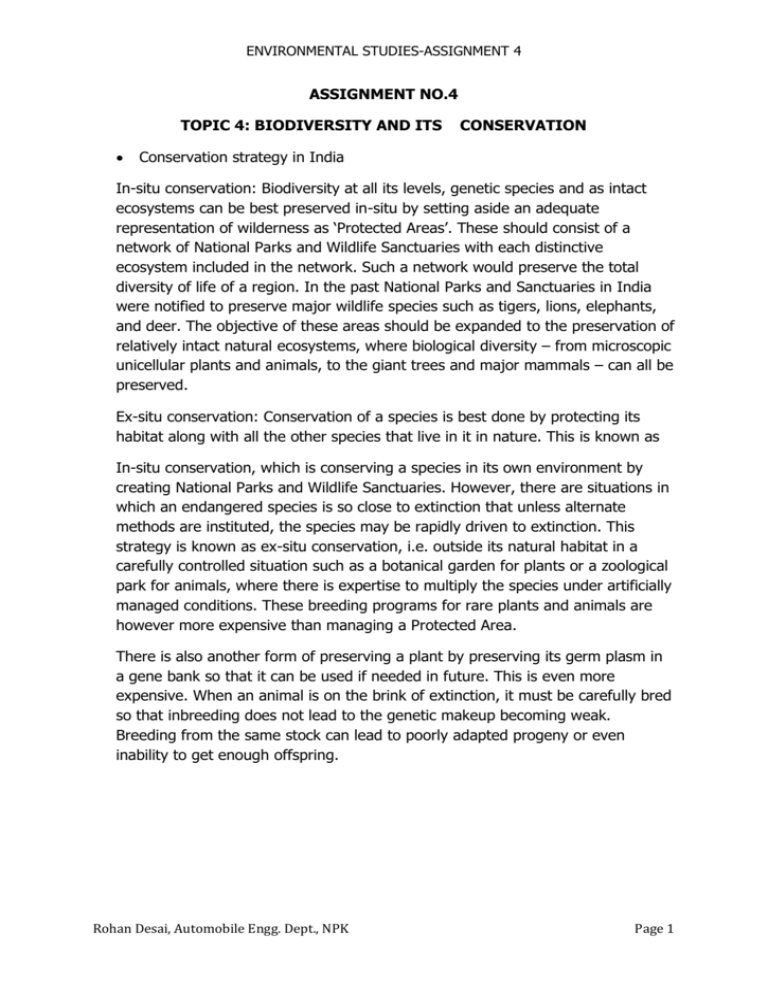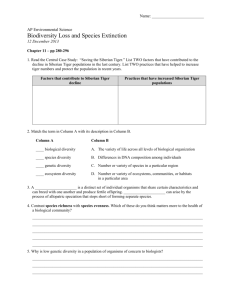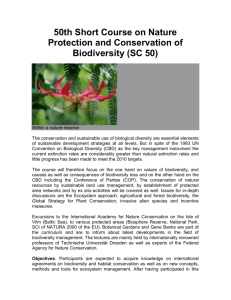Assignment 04
advertisement

ENVIRONMENTAL STUDIES-ASSIGNMENT 4 ASSIGNMENT NO.4 TOPIC 4: BIODIVERSITY AND ITS CONSERVATION Conservation strategy in India In-situ conservation: Biodiversity at all its levels, genetic species and as intact ecosystems can be best preserved in-situ by setting aside an adequate representation of wilderness as ‘Protected Areas’. These should consist of a network of National Parks and Wildlife Sanctuaries with each distinctive ecosystem included in the network. Such a network would preserve the total diversity of life of a region. In the past National Parks and Sanctuaries in India were notified to preserve major wildlife species such as tigers, lions, elephants, and deer. The objective of these areas should be expanded to the preservation of relatively intact natural ecosystems, where biological diversity – from microscopic unicellular plants and animals, to the giant trees and major mammals – can all be preserved. Ex-situ conservation: Conservation of a species is best done by protecting its habitat along with all the other species that live in it in nature. This is known as In-situ conservation, which is conserving a species in its own environment by creating National Parks and Wildlife Sanctuaries. However, there are situations in which an endangered species is so close to extinction that unless alternate methods are instituted, the species may be rapidly driven to extinction. This strategy is known as ex-situ conservation, i.e. outside its natural habitat in a carefully controlled situation such as a botanical garden for plants or a zoological park for animals, where there is expertise to multiply the species under artificially managed conditions. These breeding programs for rare plants and animals are however more expensive than managing a Protected Area. There is also another form of preserving a plant by preserving its germ plasm in a gene bank so that it can be used if needed in future. This is even more expensive. When an animal is on the brink of extinction, it must be carefully bred so that inbreeding does not lead to the genetic makeup becoming weak. Breeding from the same stock can lead to poorly adapted progeny or even inability to get enough offspring. Rohan Desai, Automobile Engg. Dept., NPK Page 1 ENVIRONMENTAL STUDIES-ASSIGNMENT 4 Project Tiger: Project Tiger was launched by the Government of India with the support of WWF-International in 1973 and was the first such initiative aimed at protecting this key species and all its habitats. Project Tiger was initiated in nine Tiger Reserves in different ecosystems of the country covering an area of 16339 sq km. By 2001 the number of Tiger Reserves increased to 27, covering an area of sqon km. tiger to count climbed from 268 in 1972 in the nine 37761 Essay theThe threats Biodiversity Tiger Reserves, to around 1500 in 1997 in the 23 Tiger Reserves. The Project tiger recognized the fact that tigers cannot be protected in isolation, and that to protect the tiger, its habitat needed to be protected. Write an essay on the threats to Biodiversity. “Every 20 minutes we lose an animal species. If this rate continues, by century's end, 50% of all living species will be gone. It is a phenomenon known as the sixth extinction. The fifth extinction took place 65 million years ago when a meteor smashed into the Earth, killing off the dinosaurs and many other species and opening the door for the rise of mammals. Currently, the sixth extinction is on track to dwarf the fifth.....” Man has begun to overuse or misuse most of these natural ecosystems. Due to this ‘unsustainable’ resource-use, once productive forests and grasslands have been turned into deserts and wasteland have increased all over the world. Mangroves have been cleared for fuel wood and prawn farming, which has led to a decrease in the habitat essential for breeding of marine fish. Wetlands have been drained to increase agricultural land. These changes have grave economic implications in the longer term. The current destruction of the remaining large areas of wilderness habitats, especially in the super diverse tropical forests and coral reefs, is the most important threat worldwide to biodiversity. Scientists have estimated that human activities are likely to eliminate approximately 10 million species by the year 2050. There are about 1.8 million species of plants and animals, large and microscopic, known to science in the world at present. The number of species however is likely to be greater by a factor of at least 10. Plants and insects as well as other forms of life not known to science are continually being identified in the worlds’ ‘hotspots’ of diversity. Unfortunately at the present rate of extinction about 25% of the worlds’ species will undergo extinction fairly rapidly. This may occur at the Rohan Desai, Automobile Engg. Dept., NPK Page 2 ENVIRONMENTAL STUDIES-ASSIGNMENT 4 rate of 10 to 20 thousand species per year, a thousand to ten thousand times faster than the expected natural rate! Human actions could well exterminate 25% of the world’s species within the next twenty or thirty years. Much of this mega extinction spasm is related to human population growth, industrialization and changes in land-use patterns. A major part of these extinctions will occur in ‘bio-rich’ areas such as tropical forests, wetlands, and coral reefs. The loss of wild habitats due to rapid human population growth and short term economic development are major contributors to the rapid global destruction of biodiversity. Rohan Desai, Automobile Engg. Dept., NPK Page 3








